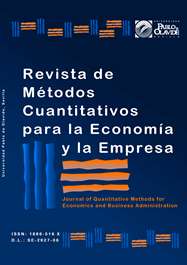Stochastic Frontier Models with Dependent Errors based on Normal and Exponential Margins
DOI:
https://doi.org/10.46661/revmetodoscuanteconempresa.2684Palabras clave:
technical and cost efficiencies, stochastic frontier, marginal distribution, dependence, Sarmanov model, eficiencias técnica y de coste, frontera estocástica, distribución marginal, dependencia, modelo de SarmanovResumen
Continuando el reciente trabajo de Gómez-Déniz y Pérez-Rodríguez (2014), el presente artículo extiende los resultados obtenidos a la distribución normal-exponencial con dependencia. En consecuencia, el principal propósito de este artículo es mejorar el modelado de la frontera estocástica tanto de producción como de coste proponiendo para ello una distribución bivariante para errores dependientes que nos permitan encajar los modelos clásicos. Se obtienen las expresiones en forma cerrada para el término de error y la eficiencia técnica. Se ilustra la aplicabilidad del modelo propouesto usando datos reales existentes en la literatura econométrica.
Descargas
Citas
Aigner, D., Knox Lovell, C.A. and Schmidt, P. (1977). Formulation and Estimation of Stochastic Frontier Function Models. Journal of Econometrics, 6, 21-37.
Amblard, C. and Girard, S. (2009). A new extension of bivariate FGM copulas. Metrika, 70, 1-17.
Amsler, C., Prokhorov, A. and Schmidt P. (2016). Endogeneity in stochastic frontier models. Journal of Econometrics, 190:2, 280-288.
Battese, G. and Corra, G. (1977). Estimation of a production frontier model: With application to the pastoral zone of Eastern Australia. Australian Journal of Agricultural Economics, 21:3, 169-179.
Battese, G. E. and T. J. Coelli. (1988). Prediction of firm-level technical efficiencies with a generalized frontier production function and panel data. Journal of Econometrics, 38, 387-99.
Bonett, D.G. (2000). Sample size requirements for estimating Pearson, Kendall and Spearman correlations. Psychometrika, 65:1, 23-28.
Dingman, H.F. and Perry, N.C. (1956). A comparison of the accuracy of the formula for the standard error of Pearson "r" with the accuracy of Fishers z-Transformation. The Journal of Experimental Education, 24:4, 319-321.
El Mehdia, R. and Hafner, C.M. (2014). Inference in stochastic frontier analysis with dependent error terms. Mathematics and Computers in Simulation, 102, 104-116.
Fredricks, G.A. and Nelsen, R.B. (2007). On the relationship between Spearman's rho and Kendall's tau for pairs of continuous random variables. Journal of Statistical Planning and Inference, 137, 2143-2150.
Gómez-Déniz, E. and Pérez-Rodríguez, J.V. (2014). Closed-form solution for a bivariate distribution in stochastic frontier models with dependent errors. Journal of Productivity Analysis, 43:2, 215-223.
Greene, W. (1980a). Maximum likelihood estimation of econometric frontier functions. Journal of Econometrics, 13:1, 27-56.
Greene, W. (1980b). On the estimation of a flexible frontier production model. Journal of Econometrics, 13:1, 101-115.
Greene, W. (1990). A Gamma distributed stochastic frontier model. Journal of Econometrics, 46:1, 141-164.
Greene, W. (2003). Maximum simulated likelihood estimation of the Normal-Gamma stochastic frontier function. Journal of Productivity Analysis, 19:2-3, 179-190.
Jondron, J.; Lovell, C.A.; Materov, I.S. and Schmidt, P. (1982). On the estimation of technical inefficiency in the stochastic frontier production function model. Journal of Econometrics, 19, 233-238.
Kumbhakar, S.C. and Lovell, C. A. (2000). Stochastic Frontiers Analysis. Cambridge University Press.
Lee, L.-F. (1983). A test for distributional assumptions for the stochastic frontier functions. Journal of Econometrics, 22:3, 245-267.
Lee, T.M.L. (1996). Properties and applications of the Sarmanov family of bivariate distributions. Communications Statistics: Theory and Methods, 25:6, 1207-1222.
Meeusen, W. and Van Den Broeck, J. (1977). Efficiency estimation from Cobb-Douglas production function with composed error. International Economic Review, 18, 435-444.
Park, Y.-H. and Fader, P.S. (2004). Modeling browsing behavior at multiple websites. Marketing Science, 23:3, 280-303.
Sarabia, J.M. and Gómez-Déniz, E. (2011). Multivariate Poisson-Beta distributions with applications. Communications in Statistics: Theory and Methods, 40, 1093-1108.
Sarmanov, O.V. (1966). Generalized normal correlation and two-dimensional Frechet classes. Doklady (Soviet Mathematics), 168, 596-599.
Shubina, M. and Lee, T.M.L. (2004). On maximum attainable correlation and other measures of dependence for the Sarmanov family of bivariate distributions. Communications in Statistics: Theory and Methods, 33:5, 1031-1052.
Smith, M. (2008). Stochastic frontier models with dependent error components. Econometrics Journal, 11, 172-192.
Stevenson, R. (1980). Likelihood functions for generalized stochastic frontier functions. Journal of Econometrics, 13, 57-66.
Tran, K. and Tsionas, M. (2015). Endogeneity in stochastic frontier models: Copulas approach without external instruments. Economics Letters, 133, 85-88.
Wiboonpongse, A.; Liu, J.; Sriboonchitta, S. and Denoeux, T. (2015). Modeling dependence between error components of the stochastic frontier model using copula: Application to intercrop coffee production in Northern Thailand. International Journal of Approximate Reasoning, 65, 34-44.
Descargas
Publicado
Cómo citar
Número
Sección
Licencia
Derechos de autor 2017 Revista de Métodos Cuantitativos para la Economía y la Empresa

Esta obra está bajo una licencia internacional Creative Commons Atribución-CompartirIgual 4.0.
El envío de un manuscrito a la Revista supone que el trabajo no ha sido publicado anteriormente (excepto en la forma de un abstract o como parte de una tesis), que no está bajo consideración para su publicación en ninguna otra revista o editorial y que, en caso de aceptación, los autores están conforme con la transferencia automática del copyright a la Revista para su publicación y difusión. Los autores retendrán los derechos de autor para usar y compartir su artículo con un uso personal, institucional o con fines docentes; igualmente retiene los derechos de patente, de marca registrada (en caso de que sean aplicables) o derechos morales de autor (incluyendo los datos de investigación).
Los artículos publicados en la Revista están sujetos a la licencia Creative Commons CC-BY-SA de tipo Reconocimiento-CompartirIgual. Se permite el uso comercial de la obra, reconociendo su autoría, y de las posibles obras derivadas, la distribución de las cuales se debe hacer con una licencia igual a la que regula la obra original.
Hasta el volumen 21 se ha estado empleando la versión de licencia CC-BY-SA 3.0 ES y se ha comenzado a usar la versión CC-BY-SA 4.0 desde el volumen 22.










